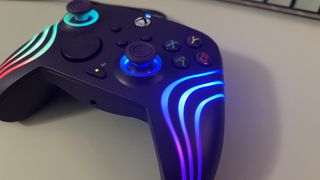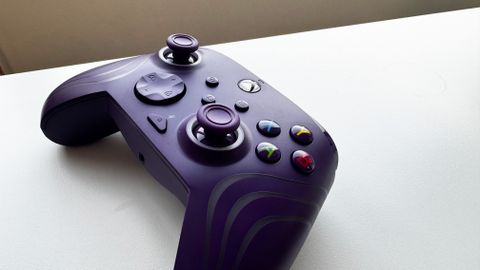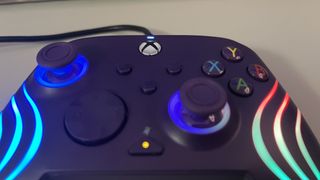Our Verdict
This controller does most of the things a controller needs to do but doesn't really thrive in any way. PDP’s offering may stand out with those colours but doesn't make a wave after that glow.
For
- Decent price
- Programmable buttons
- Colourful RGB options
Against
- Only wired
- Some stiff and imprecise controls
- Inconsistent connectivity
PC Gamer's got your back
A lot of third-party game controllers are missing some of the key features that make the Xbox Series X controller work so well, and this can make it hard to justify losing them for a small price decrease. It is, after all, the best PC controller and has become a bit of a gold standard for all others. When so many companies attempt to mimic that formula, they need to get lots of things right to not seem like a pale imitation
The PDP Afterglow Wave feels like your second peripheral. You’ve seen what first-party products have to offer and they’re worth the money but now, you don’t necessarily need that extra controller. You just want one spare for a buddy. That buddy’s fingers will light up with the glorious glow of RGB lighting when they pick it up but they might just bring their own controller next time.
That RGB lighting is incredibly noticeable the first time you plug it in. With my model coming in purple, it doesn't quite look right when the lights are off. There's so much room around the controller for all that RGB that it looks a little hollow when it's not on. Luckily, when plugged in, the PDP Afterglow Wave looks pretty great. Lighting wraps around the front of each of the two grips and highlights the thumbsticks, which actually makes it a surprisingly viable option in the dark.
That lighting can be customized easily with a button in the middle of the controller. It can be double-tapped to mute and unmute or held down while pressing the right bumper to cycle through lighting modes. It's all intuitive and quite responsive.
Windows and Xbox devices have the downloadable PDP Control Hub, which allows you to customize lighting, test sticks, and calibrate the controller without having to use shortcuts. It's a barebones yet handy app that works particularly well on Xbox, thanks to the Quick Resume function. Once in that app, I did notice that the "Downflow" and "Upflow" RGB lighting options, which move from the top to bottom or vice versa, are pretty poorly made. Instead of flowing, as the name implies, it feels more like the controller is lighting up segments individually and hoping you don't notice. As a result, I ended up leaving the controller on "Wave" mode, which cycles through colours slowly, and I rarely changed it.
For a gaming controller, the PDP Afterglow Wave's controls feel secondary to everything else. Two paddles at the back of the controller can be remapped to any button, giving players easy access to a drop shot in Call of Duty or the A button if you happen to play with the dreaded "claw" technique. It has built-in functions to change volume and fade between in-game audio and voice chat, and it even has the capture button found in the Xbox Series X controller revamp. However, the buttons themselves feel just okay.

Both bumpers have a satisfying click, yet clicking the thumbstick causes a reverberation in the controller that feels a bit uncomfortable. Both triggers, though functionally fine, feel a tad flimsy, and the grips are textured in a way that feels more for show than to actually avoid it slipping out of your hands. As an extension of this, everything in this controller is for show, and it… shows.
The Xbox Series X's D-pad feels like a bit of a mystery to me. For years, game enjoyers have praised individual directional buttons instead of pads, as a pad can not only feel limiting but a bit stiff. Somehow, Microsoft managed to nail the feel – being great despite connecting all those buttons. PDP's Afterglow Wave attempts a similar style of D-pad that feels far too inconsistent. I've been testing out Brotato, a fun little roguelike on Xbox Game Pass that has a heavy focus on movement. Using the thumbsticks, it functions perfectly fine. Using just the D-pad, my runs are cut short and I'm left frustrated due to how clumsy everything feels. Even Dicey Dungeons, a turn-based dice roguelike where you slowly choose your moves, performed significantly below my other controllers when movement is controlled exclusively with the D-pad.



✅ You're looking for a cheap Xbox controller alternative: With the same basic layout as a traditional Xbox controller, it will feel familiar to anyone used to Microsoft's option but at a cheaper rate.
✅ You want lots of RGB: For its faults, this is a very visually striking controller and great for someone who likes to show off.
✅ You want programmable buttons: Thanks to two extra buttons on the controller, this is a great choice if you need access to a button your fingers would normally take a few seconds to get to.
❌ You regularly use the D-pad: This D-pad, while fine for singular touches and the occasional hit, is very poor for bullet hells, roguelikes, and fighting games.
❌ You don't like the restrictions of a wire: Without any wireless options, this can feel limiting in the wrong space.
❌ You can wait for a sale: The standard Xbox Series X controller goes on sale regularly for a similar price and is, all around, a much better offering.
It's worth pointing out that, though the PDP Afterglow Wave is around $25 below the traditional Xbox controller, sales leave both controllers around the same price. Given you miss out on wireless connectivity and have to put up with many of the elements PDP tries to mimic Microsoft's superior choice, this budget option only really feels like a budget option if you can't wait for a sale.
On PC, plugging in the controller and clicking in the middle button consistently connects but I noticed a bit of a peculiar problem with the Xbox. The first time I plugged it in, tapping the Xbox button didn't turn on the Xbox, as I would have expected. I assumed this was just a flaw and went on about my day. Two days later, clicking that button again turned it on. Instead of either working or not working to turn on the Xbox, the controller inconsistently functions. This is almost more annoying as it requires unplugging and plugging in the wire again, before hoping it actually works. When plugged in and running the PDP Control Hub, I could physically see the controller disconnecting in front of my eyes.
This is not the first time I've used an Afterglow controller. I picked up the PDP Afterglow Prismatic way back in 2016 as my standard Xbox One controller didn't have a 3.5mm headset jack and the Prismatic did. I have left the last few weeks feeling much of the same way about the Afterglow Wave as I did the Prismatic. Those pretty colours are an interesting addition to my controller collection but it's too flimsy and gimmicky to outlast the classics.
This controller does most of the things a controller needs to do but doesn't really thrive in any way. PDP’s offering may stand out with those colours but doesn't make a wave after that glow.
James is a more recent PC gaming convert, often admiring graphics cards, cases, and motherboards from afar. It was not until 2019, after just finishing a degree in law and media, that they decided to throw out the last few years of education, build their PC, and start writing about gaming instead. In that time, he has covered the latest doodads, contraptions, and gismos, and loved every second of it. Hey, it’s better than writing case briefs.

Half-Life 2: Deathmatch was the best multiplayer mode ever, or maybe I just think that because it's the only one I was ever good at

A War Of A Madman's Making is a quietly brilliant, totally free political sim where you have to try to survive as a deranged dictator's henchman
From extensive lore-friendly research to diabolical wordplay: All the different ways we name our beloved videogame characters

